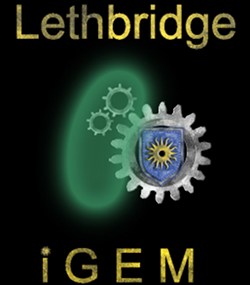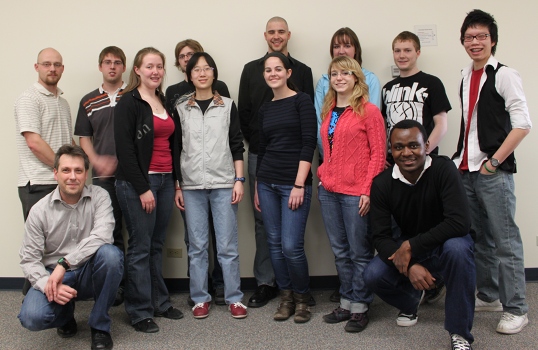Team:Lethbridge/Notebook/Protocols
From 2010.igem.org
(Difference between revisions)
(→Overexpression) |
(→Overexpression) |
||
| Line 103: | Line 103: | ||
<li>To run SDS PAGE, centrifuge the samples at 13,000 rpm for 5 minutes and discard the supernatant. Resuspend the cell pellets with 100µL of 8M urea. Mix 10µL of the urea/cell sample with 5µL of 6X loading dye. | <li>To run SDS PAGE, centrifuge the samples at 13,000 rpm for 5 minutes and discard the supernatant. Resuspend the cell pellets with 100µL of 8M urea. Mix 10µL of the urea/cell sample with 5µL of 6X loading dye. | ||
</ol> | </ol> | ||
| + | |||
| + | ==Maxiprep== | ||
| + | <ol> | ||
| + | <li>Grow up a 500mL overnight culture | ||
Revision as of 19:49, 26 July 2010
Back to Notebook
Contents |
Common Protocols:
Competent Cell Transformation
- Thaw 20µL of aliquotted cells (DH5α or BL21(DE3)) on ice.
- Gently pipet 2.0µL of DNA into competent cells
ATTENTION:
Do not perform any additional mixing
Never use more DNA that 10% of the volume of the competent cells otherwise the cells get destroyed by osmotic shock - Incubate the cells on ice for 30 minutes.
- Heat shock the cells in a water bath at 42oC for EXACTLY 45 seconds.
- Incubate the cells on ice for 5 minutes.
- Add 250µL sterile media to the cells and incubate at 37oC for 1 hour with shaking (200RPM).
- Plate 100µL and 50µL on prewarmed LB agar plate containing the appropriate antibiotic.
For ligations, plate all 250µL. - Leave plate for 10-15 minutes to soak the cell suspension into the agar.
- Flip plate over (agar on top)
- Incubate the plates in the 37oC incubator overnight
Boiling Lysis Plasmid Preparation (Miniprep)
- Aseptically transfer 1.5mL of each overnight culture to a 1.5mL microcentrifuge tube (MCT) and pellet the cells by centrifugation in a benchtop microcentrifuge (2min at 13000RPM)
- Remove and discard as much of the supernatant as possible by aspiration (e.g with a Pasteur Pipette). Do not suck up the cell pellet!!
- Rinse the cell pellet by washing 1.0mL of sterile MilliQ H2O gently down the inside wall of the MCT. This removes any traces of the supernatant adhering to the MCT wall while minimizing the disturbance to the cell pellet. (/li>
- Resuspend the cell pellet in 350µL of STET.
- Add 25µL of the Lysozyme solution and mix by inversion.
- Place the MCT in the bioling water bath for EXACTLY 35 seconds, remove and incubate on ice for 5 minutes.
- Pellet the cellular debris by centrifugation at 13000RPM for 15 minutes. Transfer the supernatant to a fresh MCT and discard the pellet.
- Precipitate the plasmid DNA by adding 40µL of 3.0M sodium acetate (pH 5.2) and 420µL isopropanol. Mix by inversion. Mix by inversion and incubate for 5 minutes at room temperature.
- Pellet the plasmid DNA by centrifugation at 13000RPM for 10 minutes at 4oC. A pellet of plasmid DNA should be visible at the base of the MCT when complete.
- Being careful not to disturb the pellet, discard the supernatant and rinse the pellet with 500µL of ice cold ethanol.
- Repeat above step.
- Invert and tap the open MCT several times against a piece of paper towel on your bench to remove as much ethanol as possible.
- Store the open MCT at room temperature for approximately 10 minutes to allow all remaining traces of ethanol to evaporate
- Add 50µL of TE (pH 8.0) containing RNase A and resuspend the plasmid DNA by flicking the base of the MCT with your finger. The plasmid DNA is ready for use or can be stored long term at -20oC.
Restriction of Plasmid DNA (pDNA)
Ligation of BioBricks
Overexpression
- Inoculate two 5mL overnight cultures in LB media containing the appropriate antibiotic corresponding to the resistance of the plasmid backbone on which the gene is located; incubated at at 37oC in shaker.
- Transfer the two 5mL cultures into an 2000mL Erlenmeyer flask containing 500mL of LB media containing the same antibiotic.
- Measure and record initial read OD600 reading (Time = 0) blanking against the unincoulated LB media.
- Begin incubation at 37oC in shaker.
- Measure and record another OD600 reading 1 hour after (Time = 1) and continue record OD600 every 30 minutes (T + 0.5) until OD600 = 0.600 is reached.
- When OD600 has reached 0.600, aliquot out a 2mL sample and induce the 500mL culture (ie. if promoter is pLacI, induce with IPTG) and continue incubating in 37oC shaker.
- Aliquot 2mL samples and record the OD600 reading every hour for 3 hours following induction.
- To run SDS PAGE, centrifuge the samples at 13,000 rpm for 5 minutes and discard the supernatant. Resuspend the cell pellets with 100µL of 8M urea. Mix 10µL of the urea/cell sample with 5µL of 6X loading dye.
Maxiprep
- Grow up a 500mL overnight culture
 "
"


 ]
]
 ]
]
 ]
]
 ]
]
 ]
]
 ]
]
 ]
]
 ]
]